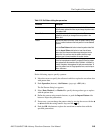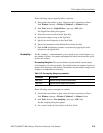
The Graphical Waveform Editor
3-72 AWG710&AWG710B Arbitrary Waveform Generator User Manual
The Tools Menu
The Tools menu performs mathematical operations on the entire waveform data
record you are currently editing. There are two mathematical operations:
Single Waveform Math, which performs the specified mathematical operation
on the currently edited waveform.
Dual Waveform Math, which performs a specified mathematical operation
between the currently edited waveform and a different waveform.
The math operations do not change the marker data.
The math waveform operations apply to the whole waveform rather than merely
the edit area. The waveform math commands opens a new window that contains
the waveform data that is the result of the math operation. The operation uses the
values of the points on the waveform or waveforms for input, and performs the
operation, point by point, to generate the results.
If a math operation creates a waveform with values greater than ±1.0, you can use
the Zoom/Pan (bottom) commands to view the part of waveform that lies outside
the window. The instrument retains the calculated values even if they exceed the
current editor settings. Use the Normalize command to scale the signal values to a
±1.0 DAC range.
For Dual Waveform Math, there may be a mismatch between the data lengths of
the two input waveforms. The output waveform’s data length will equal the shorter
of the two compared waveforms.
Table 3-13 lists the waveform math commands along with the equation used to
calculate the new waveform data. Information regarding more complicated
commands follow Table 3-13.
NOTE. If you perform a math operation that needs to create a new window, and
there are three windows already open, the math command displays an error
message.
Table 3-13: Mathematical function commands
Command Equation
1
Description
Absolute G(x) = | F1(x) | Creates a new waveform that is the absolute
value of the points in the source waveform.
Square G(x) = ( F1(x) )
2
: F1(x)
y
0
G(x) = - ( F1(x) )
2
: F1(x) < 0
Creates a new waveform that is the squared
value of the points in the source waveform.
Cube G(x) = ( F(x) )
3
Creates a new waveform that is the cubed value
of the points in the source waveform.


















